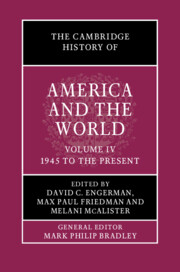Book contents
- The Cambridge History of America and the World
- The Cambridge History of America and the World
- The Cambridge History of America and the World
- Copyright page
- Contents
- Figures
- Maps
- Contributors to Volume IV
- General Introduction: What is America and the World?
- Introduction to Volume IV
- Part I Ordering a World of States
- 1 Global Capitalist Infrastructure and US Power
- 2 Overseas Bases and the Expansion of US Military Presence
- 3 The Consolidation of the Nuclear Age
- 4 American Knowledge of the World
- 5 The American Construction of the Communist Threat
- 6 The Fractured World of the Cold War
- 7 The US and the United Nations System
- 8 American Development Aid, Decolonization, and the Cold War
- 9 Decolonization and US Intervention in Asia
- Part II Challenging a World of States
- Part III New World Disorder?
- Index
8 - American Development Aid, Decolonization, and the Cold War
from Part I - Ordering a World of States
Published online by Cambridge University Press: 12 November 2021
- The Cambridge History of America and the World
- The Cambridge History of America and the World
- The Cambridge History of America and the World
- Copyright page
- Contents
- Figures
- Maps
- Contributors to Volume IV
- General Introduction: What is America and the World?
- Introduction to Volume IV
- Part I Ordering a World of States
- 1 Global Capitalist Infrastructure and US Power
- 2 Overseas Bases and the Expansion of US Military Presence
- 3 The Consolidation of the Nuclear Age
- 4 American Knowledge of the World
- 5 The American Construction of the Communist Threat
- 6 The Fractured World of the Cold War
- 7 The US and the United Nations System
- 8 American Development Aid, Decolonization, and the Cold War
- 9 Decolonization and US Intervention in Asia
- Part II Challenging a World of States
- Part III New World Disorder?
- Index
Summary
Development assistance served as an important tool of American foreign policy in the postwar decades, when the United States was confronted with a series of new challenges and opportunities arising from the global constellation coproduced by the Cold War and the decolonization of the former European colonies in Africa and Asia. The ways in which American governmental and nongovernmental organizations employed development aid were highly diverse. Military aid and relatively small technical assistance programs dominated the agenda when the first wave of decolonization took place in Asia. When the African colonies began to gain independence in the late 1950s, at the same time that the Soviet Union became a stronger presence in the so-called Third World, US aid budgets and purposes increased notably. While the United States provided the largest total amounts of aid, the development field internationalized rapidly in the postwar years, and within the Western bloc there was at times little agreement about best practices and appropriate contribution levels.
- Type
- Chapter
- Information
- The Cambridge History of America and the World , pp. 190 - 212Publisher: Cambridge University PressPrint publication year: 2022

